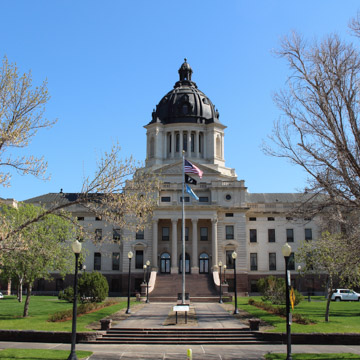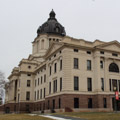The South Dakota State Capitol sits on a bluff above the Missouri River overlooking Pierre. The dome atop the building is visible for miles, and the capitol is surrounded by extensively landscaped grounds that include a small lake, gardens, and several memorials. State legislators authorized the construction of a capitol building in 1905 and, to save money, the state requested that Minneapolis architectural firm Bell and Detweiler complete a variation of the state capitol they had recently completed for Montana, rather than commissioning an original design. South Dakota’s Grand Lodge of Masons laid the cornerstone on June 25, 1908, and the building was dedicated June 30, 1910.
The four-story Classical Revival building features a copper dome, Corinthian columns, and walls of Marquette raindrop sandstone and Bedford limestone. Fieldstones from the surrounding area form the bed on which the granite foundation rests. Native granite is also used for the steps and some of the window trim. The interior is highly decorated with intricately designed woodwork, cast brass, scagliola, and terrazzo tile floors laid by Italian craftsmen. Vermont and Italian marbles comprise the grand stairway and its railings, the wainscoting on the first through third floors, drinking fountains, and can be found in the Senate chambers. The central rotunda is flanked by legislative wings, with the Senate and House chambers on the third floor and public galleries for both on the fourth. Four round, ten-foot-diameter allegorical paintings in the dome’s pendentives, depicting agriculture, livestock, industry, and family, respectively, were completed by Edward Simmons. Sculptures by Gutzon Borglum, who completed Mount Rushmore, are in the rotunda. Charles Holloway painted three murals for the capitol: The Mercy of the Law, The Louisiana Purchase, and The Peace that Passes Understanding. The capitol also features paintings by South Dakota’s first artist laureate, Oscar Howe, as well as more recent paintings by the state’s current artist laureate, Dale Lamphere.
Architect C.E. Bell’s later firm, Bell and Kinports, built an addition on the rear (north) facade in 1932. Its classical architecture blends with the earlier building. In anticipation of the 1989 state centennial, the capitol underwent an extensive restoration beginning in 1977, including interior marble replacement, scagliola restoration, and exterior stone work. More recently, in 2014, the South Dakota State Capitol celebrated the state’s 125th anniversary with the completion of a monumental stained glass restoration project by Conrad Schmitt Studios.













